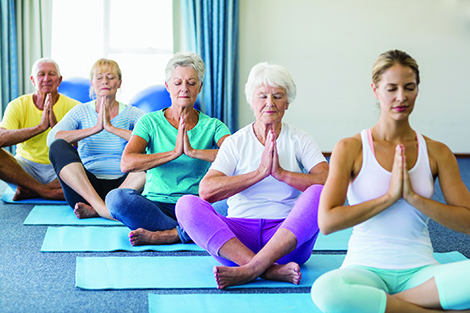The body’s core is literally the center of everything, and is comprised of the back, abdominal area, hip, and pelvic muscles. A strong core is essential to overall health, including the following benefits:
- It supports the spine, in turn keeping you balanced and stable to walk, go to the bathroom, etc. Core exercises also improves the sense of your center of gravity, which leads to more stable movement.
- As age advances, it is harder to heal from an injury than avoid one. That being said, and while accidents can and do arise, core and overall strength can lessen the risk of falls and other injuries.
- A majority of older adults suffer from lower-back pain. Core exercises help stretch and strengthen the muscles that support the lower back, subsequently reducing such pain.
- A weak core can make performing day-to-day tasks difficult, and even potentially dangerous. Maintaining core strength makes performing daily tasks much more manageable, ultimately keeping seniors independent for as long as possible.
Before starting any sort of exercise regimen to strengthen your core, it’s always important to consult with your primary care provider to lower the risk of injury. Following approval from a healthcare professional, these core strength exercises have shown to be highly beneficial:
Leg lifts. Start by lying flat on your back with legs flat and feet relaxed. Slowly lift one leg about five inches off the floor, all while contracting the abdominal muscles. Hold the position and count to three, lower the leg, and repeat with the other. Aim for 10 repetitions per leg. For a modified variation, sit in a chair, then slowly bring up both knees, return to the starting position, and complete three sets of 10 reps.
Seated twists. Sit on a sturdy chair, place feet firmly on the ground in front of you, place your arms across your chest, and lean back as far as you comfortably can. While engaging your core muscles, twist your torso to the left, return to the starting position, and twist to the right. Complete three sets of 15 repetitions each, or work to that number.
Side bends. Start in the standing position with your feet flat on the floor and chest facing straight ahead. Place one hand behind your head and the other stretched to the side. With the stretched arm, lean over as if you are reaching toward the floor. While contracting your oblique muscles, return to the starting position. Repeat five times on each side for a total of two to three sets, and feel free to sit down in a chair as needed.
Wood chops. Stand with feet wider than shoulder-width, then clasp hands in front of the body. Pull up your arms to one side of the body and diagonally “chop†and squat down toward the opposite side. Keep the core tight, along with the knees slightly bent. Repeat for 10 reps, then move to the next side for a total of two to three sets.
Yoga and Pilates. Yoga and Pilates promotes stability and flexibility, along with targeting and activating the core muscles. There are a number of low-impact movements for seniors who are looking for a gentler form of exercise. Along with attending classes, Pilates and yoga instructional videos can be viewed in the comfort of your own home. If the rep ranges and sets are too simple or difficult to complete, simply modify to a more comfortable, yet challenging number to ensure both effectiveness and safety.

Source: BistroMD, whose services and products for senior nutrition include the Silver Cuisine line of home-delivered meals.